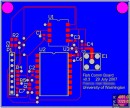I finally finished a project that has been nagging me for the past few weeks! Yah :) We have these robotic fish swimming around and they can’t talk to each other, well, until now. I designed a transceiver communication board using RF modules from Linx Technologies hoping that time would be saved. Designing a stable radio frequency (RF) circuit is fairly straightforward when you’ve got fully integrated embedded modules, but once that design is placed in a conductive medium (like water) it gets a whole lot more complicated. As if RF design wasn’t black magic already, antenna placement, receiver sensitivity and ground plane geometry become critical and will make or break a design. At least the first board revision is done and I can send it off for fabrication and component soldering (2-3 week turnaround time). Now I can get married without this thing hanging over my head. ::breathing a big sigh of relief::
Of course this means I get to look forward to hardware hacking and bug fixing once I return from the honeymoon.


